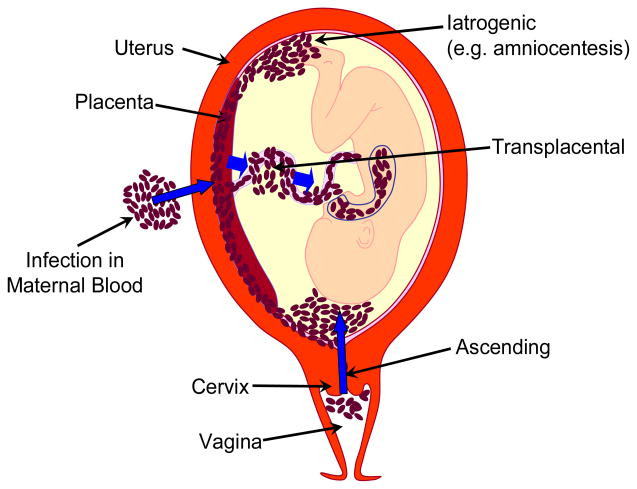Definition
Preterm Premature Rupture of Membrane (PPROM), also known as premature rupture of membranes in preterm pregnancy, is a condition where the amniotic sac ruptures before 37 weeks of gestation. Preterm or premature pregnancy can lead to complications and mortality for both the mother and the fetus. The most common causes of fetal death associated with PPROM are prematurity, sepsis, and pulmonary hypoplasia.
Prevalence
PPROM is the leading cause of 30–40% of preterm births, occurring in approximately 150,000 pregnancies each year. In singleton pregnancies, PPROM occurs in 2-4% of cases, while it rises to 7-20% in twin pregnancies.
Amniotic Fluid Production
The amniotic sac and its fluid protect the fetus from exposure to bacteria, viruses, and fungi and regulate fetal temperature to keep the fetus warm in the womb. In early pregnancy, up to 20 weeks, amniotic fluid is provided through the placenta from the mother’s body fluids.
After 20 weeks of pregnancy, the fetus takes over the production of amniotic fluid, which is produced through the fetus’s urination process, and the fetus will drink this urine. This process ensures that the fetus always has amniotic fluid in the mother's womb.
Causes
The causes of PPROM are often difficult to identify and can occur spontaneously. However, several known factors significantly contribute to PPROM, including:
- A history of PPROM or previous preterm delivery
- Infection of the uterus
- Overstretching of the uterus and amniotic sac
- Twin pregnancy
- Trauma or injury to the pregnant mother
- Pregnancy with excessive amniotic fluid
For additional information on the condition of excess amniotic fluid during pregnancy, click this link: Polyhidramnion - Definition, Cause, Symptom, And Treatment.
Risk Factor
Although the exact cause is unclear, PPROM is associated with the following risk factors:
- Low socioeconomic status
- Low education level
- Smoking
- Direct infection of the amniotic sac or cervix
- Vaginal or cervical bleeding
- Poor vaginal hygiene
- Cervix measuring less than 39 mm
- Vaginal pH above 4.5
- Nutritional deficiencies, particularly in copper or vitamin C
- History of unsterile vaginal examinations or curettage
Symptoms
The most common symptoms of PPROM include:
- Leakage of fluid from the vagina that cannot be controlled
- Constantly wet underwear and vagina
A lot of people occasionally experience difficulty distinguishing amniotic fluid from urine. Typically, amniotic fluid is clear, odorless, and does not foam.
Litmus Paper Test
You can use litmus paper to check the pH level or acidity of the fluid leaking from the vagina. If the red litmus paper turns blue when exposed to the fluid, it is likely amniotic fluid.
Diagnosis
Diagnosing PPROM involves several steps, including medical interviews, physical examinations, and additional tests.
The doctor will inquire about the mother's main complaints, accompanying symptoms, confirm the gestational age, ask about pregnancy-related complaints, laboratory results during pregnancy, previous medical history, daily habits, family medical history, and pregnancy history within the family.
Physical Examination
The doctor will then perform a physical examination to assess the overall condition of the mother and fetus. This includes checking blood pressure, body temperature, respiratory rate, and pulse. The doctor will also examine the mother's abdomen and conduct a local examination of the vagina using a lubricated speculum to assess the condition of the vagina and ensure there is no bleeding. Additionally, the doctor may perform a non-stress test and fetal biophysical profile to evaluate the fetus's health.
Diagnostic Tests
For further evaluation, the doctor may recommend tests such as blood laboratory tests to check for infection indicators in the mother, testing vaginal fluid to determine pH and detect bacteria, viruses, or fungi, and an obstetric ultrasound to confirm the amount of amniotic fluid remaining in the uterus.
Management
Treatment and therapy for PPROM depend on the symptoms and condition of the mother. Since most PPROM cases are caused by infection, management will generally differ for mothers with dominant infection symptoms versus those with less dominant symptoms.
Dominant Infection Symptoms
When a mother arrives at the hospital with clear infection symptoms, regardless of gestational age, the doctor will recommend immediate delivery to avoid severe complications for both mother and fetus.
Less Dominant Infection Symptoms
When the amniotic sac ruptures, there is no longer protection for the fetus in the womb. It becomes a ticking time bomb, and although the mother may not show signs of infection initially, the lack of protection makes it likely that she will develop infection symptoms within 1-2 weeks. If the pregnancy is almost term, the doctor will recommend delivery. However, if the pregnancy is still too early for delivery, the mother will be closely monitored, with regular ultrasounds, antibiotics, and corticosteroids administered as needed.
Complications
PPROM can lead to various complications for both the mother and the fetus or baby, including:
Maternal Complications
The most common complication for the mother is uterine infection, such as endomyometritis (infection of the uterine wall) or chorioamnionitis (infection of the amniotic sac), which can lead to sepsis.
You can learn more about amniotic membrane infections by reading this article: Korioamnionitis - Definition, Cause, Symptom, And Treatment.
Sepsis is a condition where the infection spreads throughout the body’s organs. If not properly treated, sepsis can also cause maternal death.
Additionally, if the placenta is difficult to deliver after PPROM, curettage may be required, and blood transfusions may be necessary due to significant blood loss. PPROM also increases the risk of requiring a cesarean section.
Fetal Complications
The most frequent complication for the fetus is preterm birth. Additionally, if PPROM occurs rapidly, a live-born fetus may experience conditions such as:
- Umbilical cord compression
- Oligohydramnios, which is a condition where the amniotic fluid level becomes too low
- Respiratory distress
- Neurological disorders
- Brain hemorrhage
Prevention
Unfortunately, there is no specific way to prevent PPROM. However, regular prenatal check-ups can help identify conditions that increase the risk of PPROM, allowing doctors to provide appropriate and timely care.
Reading and learning about PPROM can also help pregnant women remain calm and know what steps to take if PPROM occurs.
Additionally, always ensure:
- Adequate fluid intake during pregnancy by drinking at least 2 liters of water daily
- Limiting excessive sugar and caffeine consumption
- Avoiding smoking and alcohol
- Maintaining weight gain within normal limits
- Taking supplements and vitamins if recommended by the doctor
When to See a Doctor?
If you are less than 37 weeks pregnant and experience uncontrolled fluid leakage from the vagina, especially if your doctor has indicated that you have risk factors for PPROM, seek medical attention immediately.
Looking for more information about other diseases? Click here!
- dr Anita Larasati Priyono
Children's Hospital of Philadelphia - Premature Rupture of Membrane/Preterm Premature Rupture of Membrane. (2021). Retrieved 26 October 2022, from https://www.chop.edu/conditions-diseases/premature-rupture-membranes-prompreterm-premature-rupture-membranes-pprom
PPROM - Preterm Premature Rupture of Membrane. (2021). Retrieved 26 October 2022, from https://www.mfmnyc.com/blog/pprom-preterm-premature-rupture-of-membranes/
Sari IM., Adisasmita AC., Purnamasari R., (2020). Effect on Premature Rupture of Membranes on Preterm Labor: a case-control study in Cilegon. Retrieved 26 October 2022, from https://www.ncbi.nlm.nih.gov/pmc/articles/PMC7340614/
The PPROM Foundation - PPROM. (2021). Retrieved 26 October 2022, from https://www.aapprom.org/community/ppromfacts









